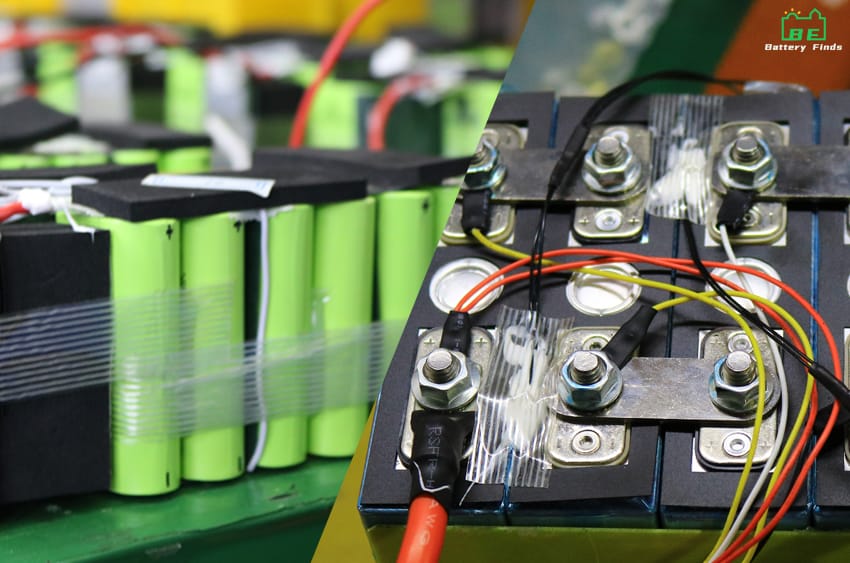There is no doubt that the shape of the battery does affect the overall performance of the entire battery pack. In terms of DIY energy storage, the most popular ones are prismatic LiFePO4 cells and cylindrical LiFePO4 cells. Both shapes of cells have obvious advantages in their respective fields, so how to choose a suitable cell is particularly important.
What are Cylindrical & Prismatic LiFePO4 Cells?

Cylindrical LiFePO4 cells, just like their name, appear as cylindrical batteries. This is the initial appearance of all mass-produced lithium batteries. The cylindrical appearance makes it easier to produce. Therefore, the cylindrical shape is also the shape of lithium batteries with the longest history and the largest size.
The prismatic LiFePO4 cell is a relatively new type of battery shape. It is said that the prismatic LiFePO4 cell is the product of the development of the electric vehicle industry. This kind of battery pays more attention to space utilization, and later, due to the large capacity of the cell, it is not widely used in general energy storage scenarios.
It is worth mentioning that there is also a battery shape called pouch battery, which has a higher utilization rate of the battery, but for some reason is not as popular as cylindrical LiFePO4 cells and prismatic LiFePO4 cells.
What’s Different Between Cylindrical & Prismatic LiFePO4 Cells?

Space Utilization
This is an important point of distinction. The space utilization of cylindrical and prismatic LiFePO4 cells is different. The prismatic square design makes it possible to arrange the cells closely, while the cylindrical type will inevitably have gaps.
The Life Span
Overall, due to the different manufacturing processes, the cylindrical type will have slightly more cycles than the prismatic LiFePO4 cell.
Weight
Cylindrical cells will be heavier because most of them have steel shells. Prismatic cells are lighter because most of them use stainless steel and aluminum shells.
Manufacturing Cost
Because cylindrical cells have a long history and simpler processing and production technology, the manufacturing cost will be relatively cheaper, while prismatic cells are relatively new, and due to the limitations of processing technology and no special standardized production specifications, So the manufacturing cost will be higher.
Damage Cost
In a battery pack composed of cylindrical cells, if one cell is damaged, it will not seriously endanger the entire battery pack. At the same capacity, damage to a prismatic cell will seriously affect the entire battery pack, which means that the cost of damage is high.
Energy Density
Relatively speaking, the energy density of prismatic LiFePO4 cells is slightly higher than that of cylindrical cells, which is determined by the structure.
Easy to Expand
Since most scenarios currently require large-capacity batteries, the option of capacity expansion has become a consideration for many people. Relatively speaking, it is more difficult to expand the capacity of cylindrical cells. Under the same capacity, cylindrical cells may need tens of thousands of cells, but prismatic cells may only need a small number, which means that prismatic cells may require only a few cells. The expansion of prismatic LiFePO4 cells is simpler.
Differences in Chemical Activity
Due to the internal structure and shape of the cylindrical cell, the electrolyte distribution inside the cell is very uniform, which is conducive to full utilization. In the inner corners of the prismatic cell, some electrolytes will be in an idle state, and the prismatic structure will exert a certain pressure on the corners. A simple summary is that the utilization rate of the electrolyte will be relatively low.
Heat Dissipation
Cylindrical cells will have better heat dissipation, because there is no way to arrange them as closely as prismatic cells, and there will be gaps between the cells, which provide space for heat dissipation.
Battery Pack Stability (with BMS)
The system stability of prismatic LiFePO4 cells will be better, because the number of cells in the battery pack will be less, so it is possible for the BMS to serve each cell independently.
Summary
In general, cylindrical LiFePO4 cells and prismatic LiFePO4 batteries have their own advantages and disadvantages, and they are all very obvious. The shape of the LiFePO4 battery you choose depends entirely on your application, but at present, the prismatic LiFePO4 battery is in a stage of rapid development, and many battery manufacturers are investing huge amounts of money in research and development, and some shortcomings are Continuous optimization. According to such a trend, there is no doubt that prismatic LiFePO4 cells will be the most mainstream energy storage batteries in the future. Of course, at this stage, prismatic LiFePO4 cells are still the most worthy option for your consideration.

